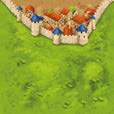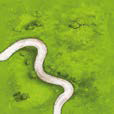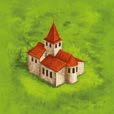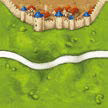Base game
Carcassonne, the world-famous French city, known for its imposing fortifications erected during the Antiquity and the Middle Ages. This fortress, surrounded by magnificent walls, still stands today as one of the most unique French cities. In this game, players must develop the area around Carcassonne. They will place their followers onto roads and into cities, monasteries, and fields. Only those who make the most judicious placements will gain the points required to win the game.
Info on farmers rules: Farmers are considered a part of the base game for most of the Carcassonne players. They are also used in every official tournament as they are not considered an expansion. In new edition of Carcassonne farmers where separated as a supplement to ease approach to the game for new players. WikiCarpedia follows this streamlined approach. Still for the sake of other expansions and the rest of the WikiCarpedia, farmers are considered a part of the base game. You can find farmers rules here The_Farmers
Components and setup
Welcome to the Carcassonne universe! This rule book was conceived to allow you to learn to play the game as fast as possible. After reading it, you will be able to explain and play the game. You are going to take your first step into the universe of the modern classic that is Carcassonne. To begin, we need to set up the game, something that only takes a few brief moments. We will also take this opportunity to present the components:
The first and most important pieces of Carcassonne are the Land tiles: there are 84 tiles which depict roads, cities, and monasteries, all of which are generally surrounded by fields.
Twelve (12) of these tiles show a river. These are explained in the supplementary rules. Other graphical elements such as houses, people, or animals have no impact on the game[1].
Every tile shares the same back, with the exception of the start tile and the twelve River tiles. The back of those tiles is darker, making them easy to set them aside.
Place the start tile (the one with a dark back) in the middle of the table. Shuffle the remaining tiles and set them as different facedown stacks that are easily accessible to all players.
Then comes the scoreboard, which you set to the side of your playing surface (table, floor, etc.).
Overview and goal of the game
Before diving into the explanation of this game, you should know what the goal is in Carcassonne. One after the other, players will place tiles. This is how, one tile at a time, a landscape of roads, cities, monasteries, and fields will be created and expanded. You may place your meeples on these tiles, where they will become highwaymen, knights, monks, and farmers and hopefully allow you to score as many points as possible. Points are not only earned during the game, but also at the very end. After the final scoring the player with the highest score is proclaimed the winner. And now, we are ready to begin!
Gameplay
A game of Carcassonne is played in clockwise order. Starting with the first player, the current player does the following actions in the order listed below, after which it is the next player’s turn, and so on and so forth. First, we’ll give you a brief description of the actions you have to do during one of your turns. These actions will be detailed as we present the roads, the cities, and finally the monasteries. So what are these actions?
Footnotes
- ↑ They have no impact considering the base rules. They are or in some case probably will be used in expansions.





